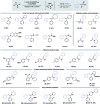Tertiary amine synthesis via reductive coupling of amides with Grignard reagents
- PMID: 29163902
- PMCID: PMC5676097
- DOI: 10.1039/c7sc03613b
Tertiary amine synthesis via reductive coupling of amides with Grignard reagents
Abstract
A new iridium catalyzed reductive coupling reaction of Grignard reagents and tertiary amides affording functionalised tertiary amine products via an efficient and technically-simple one-pot, two-stage experimental protocol, is reported. The reaction - which can be carried out on gram-scale using as little as 1 mol% Vaska's complex [IrCl(CO)(PPh3)2] and TMDS as the terminal reductant for the initial reductive activation step - tolerates a broad range of tertiary amides from (hetero)aromatic to aliphatic (branched, unbranched and formyl) and a wide variety of alkyl (linear, branched), vinyl, alkynyl and (hetero)aryl Grignard reagents. The new methodology has been applied directly to bioactive molecule synthesis and the high chemoselectivity of the reductive coupling of amide has been exploited in late stage functionalization of drug molecules. This reductive functionalisation of tertiary amides provides a new and practical solution to tertiary amine synthesis.
Figures



Similar articles
-
Difluoroalkylation of Tertiary Amides and Lactams by an Iridium-Catalyzed Reductive Reformatsky Reaction.Org Lett. 2022 Mar 18;24(10):2002-2007. doi: 10.1021/acs.orglett.2c00438. Epub 2022 Mar 8. Org Lett. 2022. PMID: 35258311 Free PMC article.
-
Iridium-Catalyzed Reductive Strecker Reaction for Late-Stage Amide and Lactam Cyanation.Angew Chem Int Ed Engl. 2017 Mar 20;56(13):3655-3659. doi: 10.1002/anie.201612367. Epub 2017 Feb 24. Angew Chem Int Ed Engl. 2017. PMID: 28233919
-
General α-Amino 1,3,4-Oxadiazole Synthesis via Late-Stage Reductive Functionalization of Tertiary Amides and Lactams*.Angew Chem Int Ed Engl. 2021 Sep 1;60(36):19725-19729. doi: 10.1002/anie.202107536. Epub 2021 Aug 3. Angew Chem Int Ed Engl. 2021. PMID: 34191400 Free PMC article.
-
General Pyrrolidine Synthesis via Iridium-Catalyzed Reductive Azomethine Ylide Generation from Tertiary Amides and Lactams.ACS Catal. 2021 Jun 18;11(12):7489-7497. doi: 10.1021/acscatal.1c01589. Epub 2021 Jun 9. ACS Catal. 2021. PMID: 34306810 Free PMC article.
-
Reductive Functionalization of Amides in Synthesis and for Modification of Bioactive Compounds.Front Chem. 2021 Apr 26;9:655849. doi: 10.3389/fchem.2021.655849. eCollection 2021. Front Chem. 2021. PMID: 33981672 Free PMC article. Review.
Cited by
-
Reductive Arylation of Amides via a Nickel-Catalyzed Suzuki-Miyaura-Coupling and Transfer-Hydrogenation Cascade.Angew Chem Int Ed Engl. 2021 Feb 1;60(5):2472-2477. doi: 10.1002/anie.202012048. Epub 2020 Nov 30. Angew Chem Int Ed Engl. 2021. PMID: 33029868 Free PMC article.
-
Mild Divergent Semireductive Transformations of Secondary and Tertiary Amides via Zirconocene Hydride Catalysis.J Am Chem Soc. 2023 Mar 8;145(9):4921-4927. doi: 10.1021/jacs.2c11786. Epub 2023 Feb 21. J Am Chem Soc. 2023. PMID: 36809854 Free PMC article.
-
Iterative addition of carbon nucleophiles to N,N-dialkyl carboxamides for synthesis of α-tertiary amines.Chem Sci. 2021 Nov 26;13(1):99-104. doi: 10.1039/d1sc05876b. eCollection 2021 Dec 22. Chem Sci. 2021. PMID: 35059156 Free PMC article.
-
A General Iridium-Catalyzed Reductive Dienamine Synthesis Allows a Five-Step Synthesis of Catharanthine via the Elusive Dehydrosecodine.J Am Chem Soc. 2021 Jul 28;143(29):10828-10835. doi: 10.1021/jacs.1c04980. Epub 2021 Jul 13. J Am Chem Soc. 2021. PMID: 34254792 Free PMC article.
-
Activation of C-O and C-N Bonds Using Non-Precious-Metal Catalysis.ACS Catal. 2020 Oct 16;10(20):12109-12126. doi: 10.1021/acscatal.0c03334. Epub 2020 Sep 10. ACS Catal. 2020. PMID: 33868770 Free PMC article. No abstract available.
References
-
- Amino group chemistry: from synthesis to the life sciences, ed. A. Ricci, Wiley VCH, Weinheim, 2008.
-
- Candeias N. R., Montalbano F., Cal P. M. S. D., Gois P. M. P. Chem. Rev. 2010;110:6169. - PubMed
- Ramadhar T. R. and Batey R. A., Boronic Acids: Preparation and Applications in Organic Synthesis, Medicine and Materials, ed. D. G. Hall, Wiley-VCH, 2nd edn, 2011, vol. 2, pp. 427–477.
-
- Beak P., Basu A., Gallagher D. J., Park Y. S., Thayumanavan S. Acc. Chem. Res. 1996;29:552.
- Hoppe D., Hense T. Angew. Chem., Int. Ed. Engl. 1997;36:2282.
- Mitchell E. A., Peschiulli A., Lefevre N., Meerpoel L., Maes B. U. W. Chem.–Eur. J. 2012;18:10092. - PubMed
-
- Le C., Liang Y., Evans R. W., Li X., MacMillan D. W. C. Nature. 2017;547:79. - PMC - PubMed
- Shaw M. H., Shurtleff V. W., Terrett J. A., Cuthbertson J. D., MacMillan D. W. C. Science. 2016;352:1304. - PMC - PubMed
- Prier C. K., MacMillan D. W. C. Chem. Sci. 2014;5:4173. - PMC - PubMed
- McNally A., Prier C. K., MacMillan D. W. C. Science. 2011;334:1114. - PMC - PubMed
- Xie J., Rudolph M., Rominger F., Hashmi A. S. K. Angew. Chem., Int. Ed. 2017;56:7266. - PubMed
- Ahneman D. T., Doyle A. G. Chem. Sci. 2016;7:7002. - PMC - PubMed
LinkOut - more resources
Full Text Sources
Other Literature Sources

